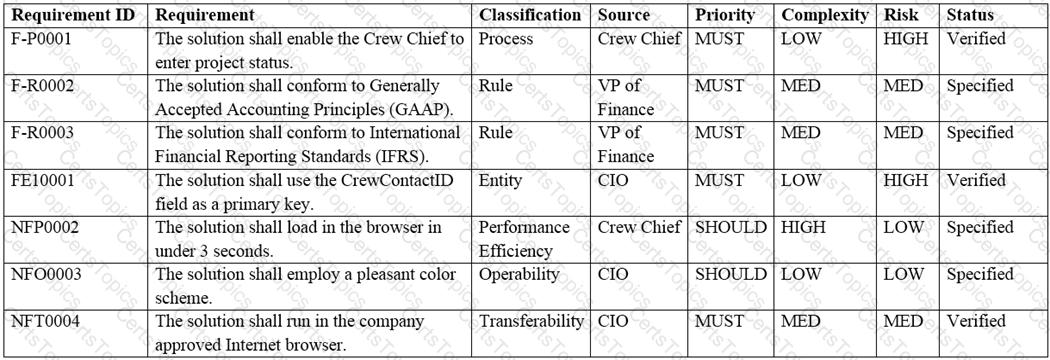As part of identifying an enterprise's capability to adopt a potential solution, a business analyst (BA) is reviewing existing processes and tools within the enterprise for their ability to adapt to a new solution.
Which of the following assessments is the BA performing?
Company A is a nation-wide leader in commercial demolition. Having just celebrated its 100th year of operations, the company decided to begin doing work internationally. The current system used for reporting company finances is unable to keep pace with the potential demands of doing work in geographically dispersed locations. Therefore, the company decided to replace its client-based Profit & Loss (P&L) reporting system with a more robust, web-based system. This will ensure transparency across the organization and enable better decision making.
The business analyst (BA) at Company A has recently completed several rounds of elicitation to determine the requirements for the new, web-based system. Over 1250 requirements were elicited. An initial Requirements Traceability Matrix (RTM) has been drafted, and a subset of the RTM can be seen below:

The risk associated with Requirement ID F-P0001 is HIGH. The BA has gone back to the Crew Chief to determine why this requirement's risk is HIGH. The Crew Chief stated that it was based on an assumption.
Which of the following assumptions would make this requirement's risk high?
A financial institution engaged in mortgage lending has embarked on a business process improvement initiative to eliminate the activities that hinder growth to ultimately improve the success rate of its mortgage business. As a benchmark for identification, the institution is keen on improving any business process that has less than a 75% success rate. The institution has appointed a business analyst (BA) to review the business transactions for the processes of origination, payments, and closures, as well as identify opportunities for improvements and recommend solutions.
The BA has collected the following information over the last three months pertaining to these business processes:
•All the business processes are at their maximum capacity in terms of the current number of transactions.
•Each business process has a certain number of rejects and the reasons for rejection include documentation, verification, collateral, and funding. Funding rejects occur when the bank's customers have failed to make payment of their mortgage processing fee or mortgage closure payment.
The BA has also recommended the use of documentation checklists as a solution to eliminate the documentation rejects.

Assuming the BA's recommendation to be true, what will be the new success rate of the mortgage closure process?
A business analyst (BA) is planning for an upcoming solution based on a signed contract with a client but has learned that one of the key subject matter experts is unavailable during the first half of the business analysis phase. The project has a tight timeline and firm deadline that is part of the contract. There are no substitutes for the key subject matter expert.
How should the BA proceed?